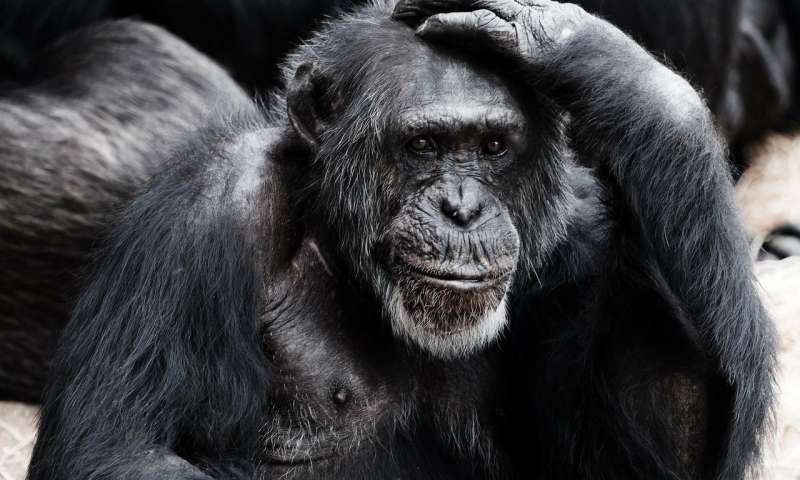Credit: CC0 Public Domain
(Phys.org)—A small team of researchers working at the Primate Research Institute at Kyoto University has found evidence that chimps are able to use gestures to convey distance to a person. In their paper published in the journal Biology Letters, the group describes experiments they carried out with chimps in a confined location, what they found and what their findings might mean for the development of symbolic communication in primates.
When people want to express distance to someone else they simply tell them using words or in some cases, use their hands to point. The ability to understand distance and convey it to another individual requires some degree of intelligence, which is why the research team in Japan wondered if chimps might the same abilities and if they did, how was it conveyed.
To find out, the team ran a series of experiments with eight chimps living at the institute. Each was allowed entry to a closed pen that was separated into two sections by bars preventing the chimps from coming into contact with the researchers. In the pen on the other side of the bars were two tables—one close to the bars, the other farther away. Each experiment consisted of a researcher coming into the table side of the pen and setting a piece of banana on one of two tables within sight of the chimp. The researcher would then leave the pen. Soon thereafter, another researcher would enter the room and begin interacting with the chimp, in effect, asking if they wanted the piece of banana. Regardless of how they chimp reacted, the researcher would retrieve the banana from the table and give it to the chimp after 15 seconds. In control experiments, the second researcher did not enter the room at all. All of the experimental runs were filmed.
In reviewing the videos of the chimps in action, the researchers found a consistent behavior between the chimps as they asked the researchers to give them the banana bit—and it was connected to which table the banana had been left on. When the banana bit was sitting on the far table, the chimps all raised their arms a little higher and opened their mouths a little wider—an apparent attempt to tell the researcher that the banana bit was farther away. This, the researchers report, indicates that the chimps were able not only to understand the concept of distance, but were able to convey it to another individual.
More information: Chloe Gonseth et al. The higher the farther: distance-specific referential gestures in chimpanzees ( Pan troglodytes ), Biology Letters (2017). DOI: 10.1098/rsbl.2017.0398
Abstract
Referential signals, such as manual pointing or deictic words, allow individuals to efficiently locate a specific entity in the environment, using distance-specific linguistic and/or gestural units. To explore the evolutionary prerequisites of such deictic ability, the present study investigates the ability of chimpanzees to adjust their communicative signals to the distance of a referent. A food-request paradigm in which the chimpanzees had to request a close or distant piece of food on a table in the presence/absence of an experimenter was employed. Our main finding concerns the chimpanzees adjusting their requesting behaviours to the distance of the food such that higher manual gestures and larger mouth openings were used to request the distant piece of food. To the best of our knowledge, this is the first study to demonstrate that chimpanzees are able to use distance-specific gestures.
Journal information: Biology Letters
© 2017 Phys.org






















